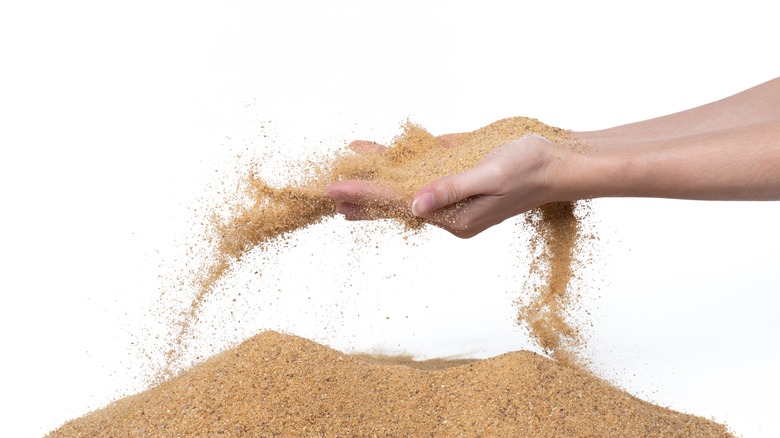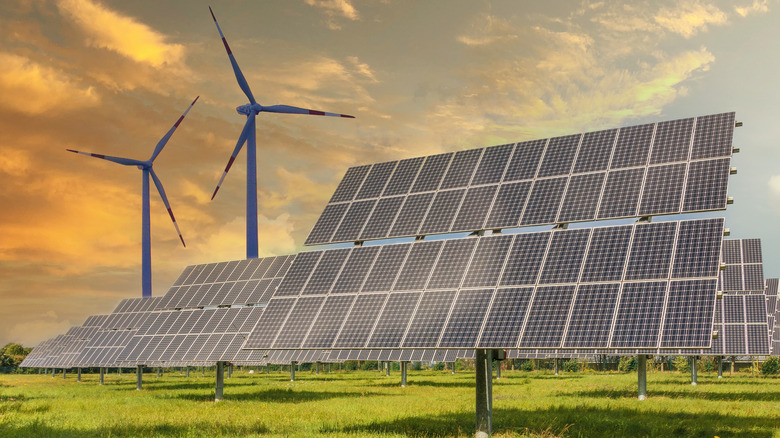Finland's Revolutionary Take On Renewable Energy, The Sand Battery
Sometimes it's nice, in an environment of doom, gloom, and apocalyptic dread, to be reminded that there's hope for a clean, beautiful Earth. Discussions of green energy have circulated for decades now. Scientists warned about global warming as early as the 1970s, as the American Institute of Physics recounts. And yet naysayers and fossil fuel devotees keep the public conversation wheel-spinning in a cycle of, "Is it really our fault, though?" refutations that prevent progress.
Thankfully, some sensible folks like those in Finland have decided to shoo away all this noise and just get down to business. So far we've got solar panels, wind turbines, hydroelectric power, geothermal power (largely fueling cryptocurrency operations, but whatever), fuel cells, and so on. Now we can add "sand battery" to the mix of energy sources that aren't the decomposed black goo of once-living creatures compressed into hydrocarbons (explained on Thought Co). Motivations are environmental, yes, but also economic and even political.
And if you're thinking, "Is it really the case that sand plus battery equals sand battery?" the answer is yes. As the BBC explains, sand batteries aren't chemical batteries like the things you shove into remote controls, but batteries in a more general sense of being used to store something. They use solar panels and wind turbines to generate heat. But instead of using the heat right away, sand batteries store it in a tank of sand.
Severing dependence on Russian energy
It's shockingly simple, right? We've all stepped on beaches, and know that sand is hot. So how about we take all that sand, which retains heat really, really well, and use it to store energy through frigid winter months in areas of the world that are struggling to keep up with rising energy costs? This is it, really — sand batteries in a nutshell. In areas of the world where people will quite literally die without proper heating, no matter how accustomed they are to cold weather — Finland, Norway, Iceland, to name a few — sand batteries could be the difference between having heat and also food, or just one or the other.
The whole sand battery thing crystallized during COVID-19, as the Borgen Project explains, and became urgent following Russia's invasion of Ukraine. Back in 2020, 38% of Finns said that energy costs "represent a noteworthy economic difficulty." Finland, like much of the world, relies on Russia for electricity and gas. After Finland announced its intention to join NATO, Russia went from temporarily cutting off Finnish energy supply to outright terminating "any exports of goods to Finland" from May 21, 2022. This means that people could really be hurting in the winter months. Having an alternative energy source is critical. Not only are sand batteries an example of easily scalable green energy, they can help countries like Finland overcome its reliance on its neighbor.
A low-cost, low-emission solution to energy crises
As De Zeen says, the first people in the world to benefit from a sand battery are folks in Kankaanpää, a town of 10,000 people in Finland. Sand batteries address a core problem with renewables like solar and wind energy that folks have groused about for awhile. Namely, that we can't control when the sun shines or the wind blows. Well, now we don't have to. Sand batteries are also low cost, low emission, and use the lowest-quality sand possible, even only "sand-like materials." To say sand batteries are revolutionary is an understatement.
The initial sand battery implemented in Kankaanpää comes from a joint venture between two Finnish companies that specialize in novel and green energy sources: Polar Energy Night and Vatajankoski. The battery stores energy for months at temperatures of 500 to 600 degrees Celsius, and needs little more than a steel tank to house its 100 tons of sand. The battery can store one gigawatt hour of energy, or one million kilowatt hours. In the U.K., this is equivalent to the energy needed to heat 1,000 homes using gas, or almost 4,200 homes using electricity. As the BBC says, whenever energy prices get too high, the battery flips on and supplements the power grid with energy derived from its own stored heat. As expected, the goal is to expand from here and build sand batteries of a "standardized size" around larger cities.


